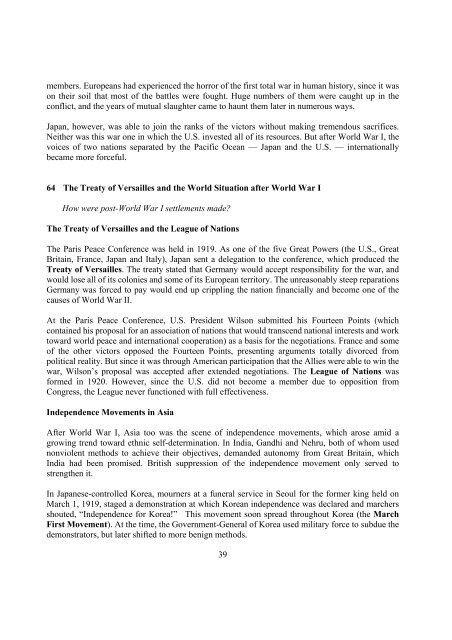New History Textbook (Chapter 4 & 5) 2005 version - Bakumatsu Films
New History Textbook (Chapter 4 & 5) 2005 version - Bakumatsu Films
New History Textbook (Chapter 4 & 5) 2005 version - Bakumatsu Films
Create successful ePaper yourself
Turn your PDF publications into a flip-book with our unique Google optimized e-Paper software.
members. Europeans had experienced the horror of the first total war in human history, since it was<br />
on their soil that most of the battles were fought. Huge numbers of them were caught up in the<br />
conflict, and the years of mutual slaughter came to haunt them later in numerous ways.<br />
Japan, however, was able to join the ranks of the victors without making tremendous sacrifices.<br />
Neither was this war one in which the U.S. invested all of its resources. But after World War I, the<br />
voices of two nations separated by the Pacific Ocean — Japan and the U.S. — internationally<br />
became more forceful.<br />
64 The Treaty of Versailles and the World Situation after World War I<br />
How were post-World War I settlements made?<br />
The Treaty of Versailles and the League of Nations<br />
The Paris Peace Conference was held in 1919. As one of the five Great Powers (the U.S., Great<br />
Britain, France, Japan and Italy), Japan sent a delegation to the conference, which produced the<br />
Treaty of Versailles. The treaty stated that Germany would accept responsibility for the war, and<br />
would lose all of its colonies and some of its European territory. The unreasonably steep reparations<br />
Germany was forced to pay would end up crippling the nation financially and become one of the<br />
causes of World War II.<br />
At the Paris Peace Conference, U.S. President Wilson submitted his Fourteen Points (which<br />
contained his proposal for an association of nations that would transcend national interests and work<br />
toward world peace and international cooperation) as a basis for the negotiations. France and some<br />
of the other victors opposed the Fourteen Points, presenting arguments totally divorced from<br />
political reality. But since it was through American participation that the Allies were able to win the<br />
war, Wilson’s proposal was accepted after extended negotiations. The League of Nations was<br />
formed in 1920. However, since the U.S. did not become a member due to opposition from<br />
Congress, the League never functioned with full effectiveness.<br />
Independence Movements in Asia<br />
After World War I, Asia too was the scene of independence movements, which arose amid a<br />
growing trend toward ethnic self-determination. In India, Gandhi and Nehru, both of whom used<br />
nonviolent methods to achieve their objectives, demanded autonomy from Great Britain, which<br />
India had been promised. British suppression of the independence movement only served to<br />
strengthen it.<br />
In Japanese-controlled Korea, mourners at a funeral service in Seoul for the former king held on<br />
March 1, 1919, staged a demonstration at which Korean independence was declared and marchers<br />
shouted, “Independence for Korea!” This movement soon spread throughout Korea (the March<br />
First Movement). At the time, the Government-General of Korea used military force to subdue the<br />
demonstrators, but later shifted to more benign methods.<br />
39













